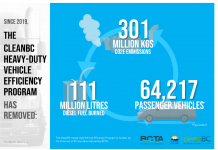Near the end of the 20th century, the term “Brain Drain” was applied to the number of doctors, scientists and career professionals that left Canada for “greener pastures” in other countries. Now Canada seems to be suffering “The Truck Driver Drain” as the trucking industry is losing its truck drivers.
More data on the Canadian Labour market and the truck driver shortage came out in April when Trucking HR Canada (THRC) provided a report in April 2023 indicating the continuing growth in the number of job vacancies in the Canadian Trucking industry.
The report revealed that there had been a decrease in Truck Drivers in Canada by the end of 2022 since before the pandemic.
The THRC report states, “New job vacancy data shows a shrinking driver workforce and growing gap between supply and demand.” Although this might be good news for those with training, experience and skills for those jobs, it also means that employers continue to face challenges in recruiting and retaining drivers.
In the trucking and logistics sector, vacancies and vacancy rates grew in 2022. Trucking is struggling to meet the demand for trucking services. While the Canadian economy continues its post-pandemic recovery, and the challenges of supply chain inconsistencies,
Data from the fourth quarter of 2022 says the vacancy rate in Truck Transportation (NAICS 484) dropped to 7.5% compared with 8.7% in Q3. The vacancy rate for 2022 was 8.6%, higher than 7.1% in 2021.
THRC says that the vacancy rate in the truck transportation industry has more than tripled since Statistics Canada began collecting this data in 2015, and is more than two times higher than in 2019 when Trucking HR Canada predicted severe shortages in the years ahead.
THRC data shows the number of Transport Truck Driver (NOC 7511) vacancies in 2022 stood at an all-time high, with almost 25,600 vacant positions, or an increase of 6,578 additional driver vacancies or 35% more than in 2019. Meanwhile, the unemployment rate among Transport Truck Drivers was only 3.4%, according to the THRC, which meant the gap in 2022 between the demand for workers and the supply of trained, experienced drivers were almost 15,200.
The THRC data shows that drivers left the field during the pandemic. Between 2021 and 2022, the Canadian labour force declined by 25,550 transport truck drivers, down from approximately 330,000 to approximately 305,000.
The CTA has been saying for many years that a growing driver shortage threatens our supply efficiency and the Canadian economy and threatens our supply chain.
Surveys by the CTA, Nanos Research and Abacus Data show Canadians are concerned about their ability to get groceries or essential products. They believe that retail inflation and supply chain pressures are partly attributable to the truck driver shortage.
This year THRC has initiated the Career ExpressWay Program, which features the federal government funding the training and onboarding of up to 2,600 new truck drivers and other trucking industry workers.
It’s a start, and so is Immigration, Refugees, and Citizenship Canada’s (IRCC) recently announced revised national occupational classification (NOC). This policy change will help open the door to permanent residency under the Express Entry immigration program for 16 new occupations, including health care, construction and transport jobs, especially for Truck Drivers.
Calls within the industry are asking for more. Those individuals want the truck driver’s job to be a “Red Seal Trade”. In other words, Truck Drivers would receive training to a national standard, with a certificate that indicates they have the training and knowledge required t that recognized trade.
Being a Truck Driver would become an honoured career to aspire to and be proud of; standardized safety would be part of training, and pay and benefits might attract more into the profession. Perhaps that would stop the departure of drivers from the industry and encourage new blood into a desired certified profession.






















